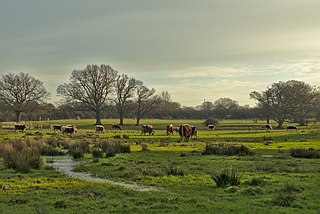The Holocene is the current geological epoch. It began approximately 9,700 years before the Common Era (BCE). It follows the Last Glacial Period, which concluded with the Holocene glacial retreat. The Holocene and the preceding Pleistocene together form the Quaternary period. The Holocene has been identified with the current warm period, known as MIS 1. It is considered by some to be an interglacial period within the Pleistocene Epoch, called the Flandrian interglacial.

The Holocene extinction, or Anthropocene extinction, is the ongoing extinction event caused by humans damaging the environment (ecocide) during the Holocene epoch. These extinctions span numerous families of plants and animals, including mammals, birds, reptiles, amphibians, fish, and invertebrates, and affecting not just terrestrial species but also large sectors of marine life. With widespread degradation of biodiversity hotspots, such as coral reefs and rainforests, as well as other areas, the vast majority of these extinctions are thought to be undocumented, as the species are undiscovered at the time of their extinction, which goes unrecorded. The current rate of extinction of species is estimated at 100 to 1,000 times higher than natural background extinction rates and is increasing.

A mammoth is any species of the extinct elephantid genus Mammuthus. The various species of mammoth were commonly equipped with long, curved tusks. They lived from the Pliocene epoch into the Holocene about 4,000 years ago, and various species existed in Africa, Europe, Asia, and North America. Mammoths are more closely related to living Asian elephants than African elephants.

The Pleistocene is the geological epoch that lasted from c. 2.58 million to 11,700 years ago, spanning the Earth's most recent period of repeated glaciations. Before a change was finally confirmed in 2009 by the International Union of Geological Sciences, the cutoff of the Pleistocene and the preceding Pliocene was regarded as being 1.806 million years Before Present (BP). Publications from earlier years may use either definition of the period. The end of the Pleistocene corresponds with the end of the last glacial period and also with the end of the Paleolithic age used in archaeology. The name is a combination of Ancient Greek πλεῖστος (pleîstos), meaning "most", and καινός, meaning "new".

In zoology, megafauna are large animals. The most common thresholds to be a megafauna are weighing over 46 kilograms (100 lb) or weighing over a tonne, 1,000 kilograms (2,205 lb). The first of these include many species not popularly thought of as overly large, and being the only few large animals left in a given range/area, such as white-tailed deer, Thomson's gazelle, and red kangaroo.

A mastodon is any proboscidean belonging to the extinct genus Mammut. Mastodons inhabited North and Central America from the late Miocene up to their extinction at the end of the Pleistocene 10,000 to 11,000 years ago. Mastodons are the most recent members of the family Mammutidae, which diverged from the ancestors of elephants at least 25 million years ago. M. americanum, the American mastodon, is the youngest and best-known species of the genus. They lived in herds and were predominantly forest-dwelling animals. M. americanum is inferred to have had a browsing diet with a preference for woody material, distinct from that of the contemporary Columbian mammoth. Mastodons became extinct as part of the Quaternary extinction event that exterminated most Pleistocene megafauna present in the Americas, believed to have been caused by a combination of climate changes at the end of the Pleistocene and hunting by recently arrived Paleo-Indians, as evidenced by a number of kill sites where mastodon remains are associated with human artifacts.

Beringia is defined today as the land and maritime area bounded on the west by the Lena River in Russia; on the east by the Mackenzie River in Canada; on the north by 72 degrees north latitude in the Chukchi Sea; and on the south by the tip of the Kamchatka Peninsula. It includes the Chukchi Sea, the Bering Sea, the Bering Strait, the Chukchi and Kamchatka Peninsulas in Russia as well as Alaska in the United States and the Yukon in Canada.

In biology, a refugium is a location which supports an isolated or relict population of a once more widespread species. This isolation (allopatry) can be due to climatic changes, geography, or human activities such as deforestation and overhunting.

During the Last Glacial Maximum, the mammoth steppe, also known as steppe-tundra, was once the Earth's most extensive biome. It stretched east-to-west, from the Iberian Peninsula in the west of Europe, across Eurasia to North America, through Beringia and Canada; from north-to-south, the steppe reached from the arctic islands southward to China. The mammoth steppe was cold and dry, and relatively featureless, though topography and geography varied considerably throughout. Some areas featured rivers which, through erosion, naturally created gorges, gulleys, or small glens. The continual glacial recession and advancement over millennia contributed more to the formation of larger valleys and different geographical features. Overall, however, the steppe is known to be flat and expansive grassland. The vegetation was dominated by palatable, high-productivity grasses, herbs and willow shrubs.
The Younger Dryas impact hypothesis (YDIH) or Clovis comet hypothesis is a speculative attempt to explain the onset of the Younger Dryas (YD) cooling at the end of the Last Glacial Period, around 12,900 years ago. The hypothesis is controversial and not widely accepted by relevant experts.
Quaternary science is the subfield of geology which studies the Quaternary Period commonly known as the ice age. The Quaternary Period is a time period that started around 2.58 million years ago and continues today. This period is divided into two epochs – the Pleistocene Epoch and the Holocene Epoch. The aim of Quaternary science is to understand everything that happened during the Pleistocene Epoch and the Holocene Epoch to be able to acquire fundamental knowledge about Earth's environment, ecosystem, climate changes, etc. Quaternary science was first studied during the nineteenth century by Georges Cuvier, a French scientist. Most Quaternary scientists have studied the history of the Quaternary to predict future changes in climate.

The latter half of the Late Pleistocene to the beginning of the Holocene saw extinctions of numerous predominantly megafaunal (large) animal species, which resulted in a collapse in faunal density and diversity across the globe. The extinctions during the Late Pleistocene are differentiated from previous extinctions by the widespread absence of ecological succession to replace these extinct megafaunal species, and the regime shift of previously established faunal relationships and habitats as a consequence. The timing and severity of the extinctions varied by region and are thought to have been driven by varying combinations of human and climatic factors. Human impact on megafauna populations is thought to have been driven by hunting ("overkill") as well as possibly environmental alteration. The relative importance of human vs climatic factors in the extinctions has been the subject of long-running controversy.
In paleoecology and ecological forecasting, a no-analog community or climate is one that is compositionally different from a baseline for measurement. Alternative naming conventions to describe no-analog communities and climates may include novel, emerging, mosaic, disharmonious and intermingled.
Lorraine Lisiecki is an American paleoclimatologist. She is a professor in the Department of Earth Sciences at the University of California, Santa Barbara. She has proposed a new analysis of the 100,000-year problem in the Milankovitch theory of climate change. She also created the analytical software behind the LR04, a "standard representation of the climate history of the last five million years".

Maureen E. "Mo" Raymo is an American paleoclimatologist and marine geologist. She is the Co-Founding Dean of the Columbia Climate School, Director of the Lamont–Doherty Earth Observatory of Columbia University, the G. Unger Vetlesen Professor of Earth & Environmental Sciences, and Director of the Lamont–Doherty Core Repository at the Lamont–Doherty Earth Observatory of Columbia University. She is the first female climate scientist and first female scientist to head the institution.

Paul Schultz Martin was an American geoscientist at the University of Arizona who developed the theory that the Pleistocene extinction of large mammals worldwide was caused by overhunting by humans. Martin's work bridged the fields of ecology, anthropology, geosciences, and paleontology.

The Beringian wolf is an extinct population of wolf that lived during the Ice Age. It inhabited what is now modern-day Alaska, Yukon, and northern British Columbia. Some of these wolves survived well into the Holocene. The Beringian wolf is an ecomorph of the gray wolf and has been comprehensively studied using a range of scientific techniques, yielding new information on the prey species and feeding behavior of prehistoric wolves. It has been determined that these wolves are morphologically distinct from modern North American wolves and genetically basal to most modern and extinct wolves. The Beringian wolf has not been assigned a subspecies classification and its relationship with the extinct European cave wolf is not clear.

Eric Holthaus is a meteorologist and climate journalist. He is the founder of a weather service called Currently and started a publication called The Phoenix on Ghost. He was formerly a writer for The Correspondent, Grist, Slate and The Wall Street Journal and is known for his mentions of global climate change.

Climate change in Maine encompasses the effects of climate change, attributed to man-made increases in atmospheric carbon dioxide, methane, and nitrous oxides, in the U.S. state of Maine. The United States Environmental Protection Agency reports that Maine has warmed roughly three degrees F since 1900. Sea level in Maine has risen eight inches since the 1950s.

The wood-pasture hypothesis is a scientific hypothesis positing that open and semi-open pastures and wood-pastures formed the predominant type of landscape in post-glacial Europe, rather than the common belief of primeval forests. The hypothesis proposes that such a landscape would be formed and maintained by large wild herbivores. Although others, including Oliver Rackham, who criticised the idea of an all-encompassing, dark primeval forest in pre-neolithic Europe, had previously expressed similar ideas, it was Dutch researcher Frans Vera, who, in his 2000 book Grazing Ecology and Forest History, first developed a comprehensive framework for such ideas and formulated them into a theorem. Vera's proposals, although highly controversial, came at a time when the role grazers played in woodlands was increasingly being reconsidered, and are credited for ushering in a period of increased reassesment and interdisciplinary research in European conservation theory and practice. Although Vera largely focused his research on the European situation, his findings could also be applied to other temperate ecological regions worldwide, especially the broadleaved ones.
















